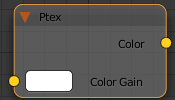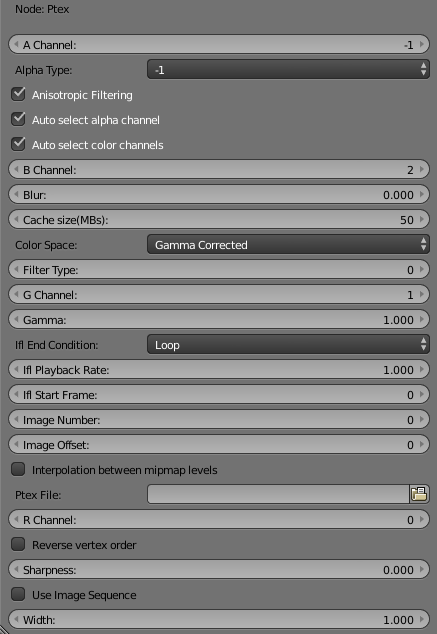This page provides information about the Ptex texture in V-Ray for Blender.
Overview
The V-Ray Ptex loads and uses PTex textures with V-Ray. PTex is a mapping system that applies a separate texture to each face of a subdivision or polygon mesh and therefore requires no UV assignment. A PTex file can store an arbitrary number of textures along with mipmaps and adjacency data used for filtering across face boundaries.
UI Path
||Node Editor|| > Add > Textures > Ptex
Node
Color Gain – A multiplier for the texture color.
Parameters
A Channel – Index of the channel used as an alpha channel.
Alpha Type – Specifies where to take the alpha from.
0 – All alpha information is ignored;
1 – The information for the alpha is taken from the specified Alpha channel in the texture;
-1 – The alpha information is taken from the Luminance of the RGB channels.
Anisotropic Filtering – Enables anisotropic texture filtering. It improves the rendering of textures when viewed at sharp angles.
Auto select alpha channel – Enable to use the automatic alpha channel selection.
Auto select color channels – A ptex may have an arbitrary number of channels and there is no guaranteed way to determine which channel contains which information. When this option is enabled, V-Ray selects the correct channel for Red, Green and Blue. When this option is off the user manually specifies which channel contains which information.
B Channel – Index of the channel used as the blue channel.
Blur – Blur parameter used for filtering.
Cache size(MBs) – The information in a PTex file is compressed for storage. In order to be used it has to be uncompressed and stored in the RAM. This parameter controls how much memory (in MB) is available for the current texture. If the value is large enough for the whole texture the information is extracted only once and is stored during the entire rendering. Otherwise the information is constantly read from the hard drive, extracted and used when necessary. Low value for this parameter may cause large PTex files to render slowly.
Color Space – Specifies the color space of the image when the gamma type option is set to Specify or when the gamma corrections are disabled:
Linear - The color data in the file is in linear physical space and no additional correction is necessary for rendering;
Gamma Corrected - The color data is gamma-encoded in the file; an inverse gamma correction is applied to the color data to convert it to linear physical space for rendering, based on the gamma value.
sRGB - The color data in the file is encoded in the sRGB color space; the standard inverse sRGB correction is applied to the colors to convert them to linear physical space for rendering. Note that sRGB color space is similar to the gamma 2.2 color space, but there are slight differences for dark colors.
Filter Type – Type of filtering used for the texture.
G Channel – Index of the channel used as the green channel.
Gamma – Manually specifies the gamma of the loaded texture when the color space is set to Gamma Corrected.
Ifl End Condition – Determines what happens when the final frame of an animated texture is reached.
Loop – If this mode is selected, the animation will jump back to the first frame.
Ping-pong – If this mode is selected, once the final frame is reached the animation will be played backwards towards the start and continue looping in a Ping-pong manner.
Hold – If this mode is selected, the animation will stop at the final frame.
Ifl Playback Rate – A coefficient for the playback rate of the animated texture. It allows you to slow down or speed up the playback rate of the texture.
Ifl Start Frame – Specifies the frame at which the playback of the texture will begin.
Image Number – Specifies the frame number of the image to load. This attribute can be animated.
Image Offset – Specifies a static offset to the image sequence.
Interpolation between mipmap levels –
Ptex File – Specifies the .ptex file to use as a texture.
R Channel – Index of the channel used as the red channel.
Reverse vertex order – A ptex is generated for a specific mesh. Sometimes the program generating the ptex numbers the vertices of the mesh in reverse order, which results in texturing issues. Enabling this option fixes that issue.
Sharpness – Specifies sharpness for the general bicubic filter.
Use Image Sequence – When enabled, animate the texture per frame.
Width – Specifies width for the filtering.



